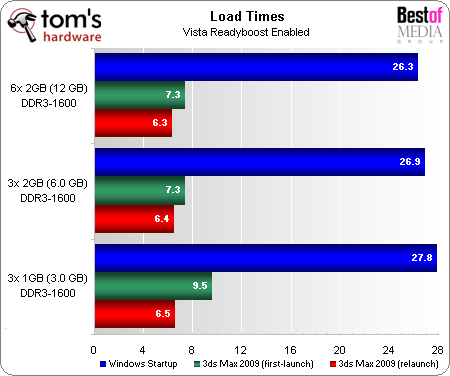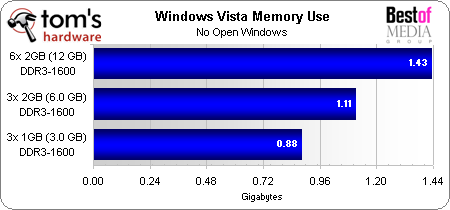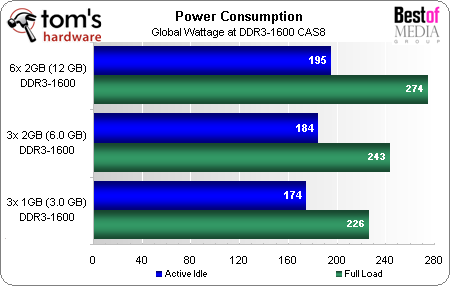Do You Really Need More Than 6 GB Of RAM?
Launch Times, Memory Use, Multitasking, And Energy Use
One of the benefits added memory is supposed to provide under Windows Vista is added space to cache more files, which enables programs to launch faster. We enabled Vista ReadyBoost, which is normally disabled as a regular part of our testing methodology, and launched several programs several times to see how large a difference those cached files would make.
Windows booted slightly faster with each increase in memory, while programs launched noticeably faster the first time following a clean reboot. However, re-launching a program resulted in a much smaller difference.
Since we were constantly rebooting and waiting for hard drive activity to cease before retests, we thought it might be good to also see how much memory Windows Vista was using to cache those startup files.
Vista responded to each memory increase by caching more files, but the reduced launch time is only noticeable the first time the program is used following a reboot.
Disappointed in the lack of performance differentiation after the program had been launched, we began various tests to determine if any “normal” user would see larger benefits during multitasking. The most common “background” applications we could think of were file downloads, video encoding, and virus scans, while the most demanding top applications are games. Because virus scans tie up the hard drive, we limited our background applications to video encoding (TMPGEnc with DivX) and file transfers (Windows Vista SP1 x64 standalone update at 726.5 MB) while retesting our Far Cry 2 benchmark. Simultaneous use of these tasks had no noticeable effect on game frame rates, and while DivX encoding times did slow down by around 60%, memory capacity did not affect those results. We even tried opening more than 100 Internet Explorer windows, but there was no noticeable impairment even with only 3 GB available.
While the only noticeable performance increase we found from adding memory was in program launch times, a non-performance test provided results of even greater significance.
Every time we doubled memory capacity, idle power consumption increased by around 10 W. Using the Sandra Memory Bandwidth benchmark, load power consumption for the entire system increased by around 10% for each increase in memory capacity.
Get Tom's Hardware's best news and in-depth reviews, straight to your inbox.
Current page: Launch Times, Memory Use, Multitasking, And Energy Use
Prev Page Performance Summary Next Page Conclusion-
EQPlayer I run 8GB in my rig because... having open memory slots doesn't jive well with my OCD. Haha. /facepalmReply -
Try opening a PSD file from a 21-Megapixel camera with 3 or more layers in Photoshop and see the difference.Reply
-
Great info for the Vista crowd. What about DDR2 and XP? Betcha there are more of us than youse guys.Reply
-
whitewhale1 can someone help me with what apps will utilise more ram?Reply
im currently researching building a workstation for photoshop and some 3d modelling to be imported and rendered in CS4
any help much appreciated im no hardware guru :) -
Crashman ReplyGreat info for the Vista crowd. What about DDR2 and XP? Betcha there are more of us than youse guys.
It's generally accepted that XP uses less RAM than Vista, so you should be fine with 4GB (which, with 32-bit XP, will yield around 3GB of usefull address space). -
shades_aus @Thomas SoderstromReply
What the heck is that image on the front with all the memory modules!
Can you supply a link with a bigger pic??? That's just insane! -
curiousgeorgieo Hey guys I was wondering: What if you had a 9g game loaded completely on a ramdrive (64bit+software) then kept the remaining 3 for regular ram?Reply -
Crashman shades_aus@Thomas Soderstrom What the heck is that image on the front with all the memory modules!Can you supply a link with a bigger pic??? That's just insane!Reply
It looks like a memory testing machine or burn-in rack to me...I'm not sure where the site found it.
curiousgeorgieoHey guys I was wondering: What if you had a 9g game loaded completely on a ramdrive (64bit+software) then kept the remaining 3 for regular ram?
That's a great idea! Because it takes sooo long to copy an entire game from the hard drive to "anything" (even RAM), most users won't even try it. But you would get super-fast map loads! -
Try using several VMs in parallel and you'll be happy to have more than 3 GB. I'm using one VM for work (image of my work notebook with VPN etc.) and one for online banking (mainly because my old smartcard isn't supported in 64bit OS, little bit of a catch22).Reply



